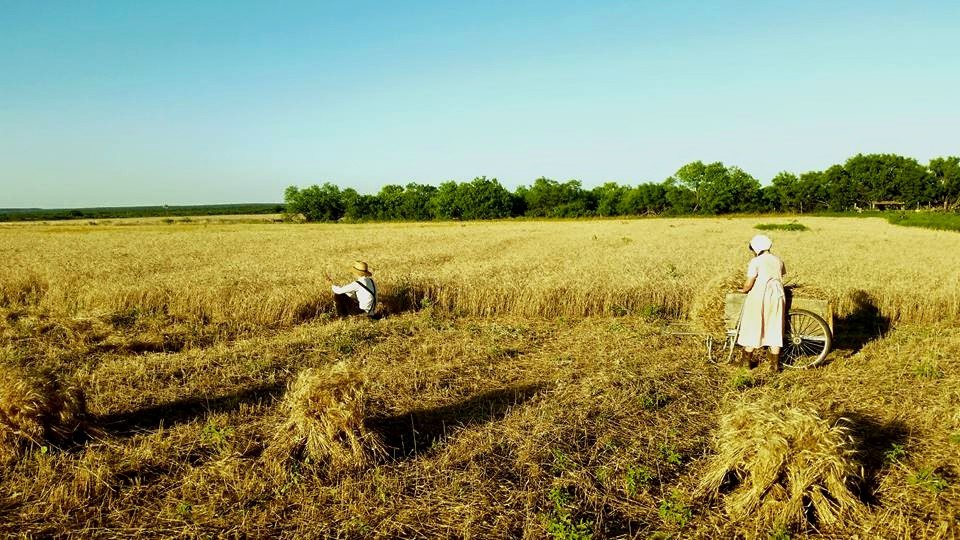I promised several people I’d do a post wherein I share our process of harvesting wheat by hand. Harvesting is actually a small part of the whole process of taking wheat from the field to a usable final product, so although I named this post “Harvesting” Wheat by Hand, I’ll actually include the post-harvest steps of threshing and winnowing.
The first step, of course, is to have some wheat ready to harvest. I know people who plant very small plots of wheat for their own consumption, and people who plant large fields of wheat. The process is the same, but you do need to start with some wheat.
We planted about three and a half acres, knowing we would probably only hand harvest a third of it. The rest can be grazed or plowed in later. This particular variety of wheat was a poor choice for us. It was short, bearded, red winter wheat. We prefer a tall, more traditional wheat so in the future we’ll do better at picking what we plant. Still, we grew it, so we harvest it.
The first step is to cut the wheat. Sickles or scythes may be used. We used sickles because the wheat was so short and our scythe really just didn’t work well. So the process is this… grab a fistful of wheat and VERY CAREFULLY, cutting away from yourself or to the side, cut the wheat at the ground. Your sickle will need to be very, very sharp. Sharpen regularly. Once you get a good thick handful of wheat all going the same direction, drop it on the ground in a pile and keep cutting. Hopefully, someone else can come along and tie the bundles into sheaves. In this video my daughter Jennifer is cutting wheat and Tracy is tying the sheaves. This was on our first day of the year, so Jennifer was just getting back in the swing of it. She’s our best cutter by far, and after a week of this, she moves about 4 times faster.
The person tying the bundles into sheaves comes along, picks up the bundles and ties them into sheaves using straw. We make pretty small sheaves since we thresh our wheat using a small treadle thresher. The bigger sheaves don’t thresh well and it adds to our work load, so we try to keep each sheave to about a fistful of wheat. Three to four pieces of wheat/straw are pulled out of the bundle and used to tie the sheave.
In our case, another person (me, usually) comes along behind the one tying sheaves and picks up the sheaves and stacks them in “stooks.” Stooks are carefully created in the fields so the wheat can continue to dry. The wheat loses water weight as it dries, and will store longer and better if it is the proper moisture content before it is stored or processed. These stooks allow air to circulate around the wheat heads, quickly drying the wheat. This picture is not from our land, because our stooks were short and goofy due to the variety of wheat we harvested. So here is a picture of big stooks with big sheaves…
In an industrial farming situation, none of this would take place. The whole process is done with one swoop by a “combine” which combines all of the steps, including threshing and winnowing, in a single pass by the machine. In some plain communities, big mechanical threshers are used (towed by horses or a tractor, if it is allowed) and the wheat sheaves are fed into the thresher from the fields or the barn.
A “thresher” beats the wheat from the wheat heads. “Winnowing,” then, takes the wheat and separates it from the chaff that surrounds it.
For us, the wheat is carried to the granary from the fields where it is stored until we get around to threshing it. We haven’t started threshing this year, and I’ll share some of that process when we start, but for now here is a video of us a few years back threshing our wheat.
I don’t have a cool visual for you on winnowing yet. When I get one, I’ll come back here and add it to this article. Basically the process is that we pick a windy day, and we use the wind to separate the wheat from the chaff. We use several buckets and big rubbermade totes to pass the wheat back and forth while the wind blows the chaff away. Then we go through and pick out any big or bad pieces that make it through the process. We finish with really clean wheat that stores well. These are some pictures from wheat crops past…
The whole point is that the way we do it is the way it has been done for thousands of years, and it isn’t altogether complicated. In my post-apocalyptic novel The Last Pilgrims, there is a traditional wheat harvest taking place on a farm 25 years after a systemic collapse destroys the industrial/consumer system of the world. When and if the stuff hits the fan, this is the way it will be done.
You can thresh and winnow without machines too, and there are plenty of YouTube videos out there showing how it is done. As I mentioned, once we get done processing the 2015 crop, I’ll update this post with some more pictures and videos!
Your friend,
Michael Bunker






where do you get your seed from. i want to plant a small plot for my personal use but am having a hard time finding seed.
Thanks
Well, we got our wheat seed from the seed store in a close town. Most seed stores keep a stock of what is usually grown in your area seasonally. If you want something in particular that is not grown in you area, or ant organic or non-gmo seed, you can either get the seed store to order it, or order it yourself online.
I grew up on a farm…it was hard labor…my granddad had a wheat field and an oat field…when the combine ran through the fields they DID NOT clean the corners or along the fence rows…we did this by hand…on hands and knees we cut the ‘edges’ by hand and tied the sheaves by hand with a handful of the loose straws from the sheaves…..we then took this to the barn and then we beat the wheat and oats from the sheeves…it was not fun…it was hard…and granddad used EVERY last grain of whatever he grew…
Whether one particular individual, family, etc. thinks a way of living is “fun” or not, is really just a matter of personal preference, and often is based on other factors, including expectations (false or otherwise,) a general sense of entitlement, or perhaps a person’s understanding of what the conditions are in the world, and what the alternatives are. Frankly, getting in a car to go to an office setting of any kind to make money to spend on things is not “fun” to us. Not at all. Too each his/her own. We revel in hard work, and understand that it is one of the costs of our freedom. Glad to know your granddad taught things of value.
Did you build the treadle thresher or did you buy it somewhere? if you built it, do you have plans available for it? If you bought it, where did you buy it?
thanks
I also would like to know if you build the treadle thresher or did you buy it somewhere? if you built it, do you have plans available for it? If you bought it, where did you buy it?
Thank you.
Thanks! We did not build this thresher. The nice people who did can be found here: http://www.backtotheland.com/html/wheat_thrasher.html
I’m at my farmland in jigawa state Nigeria how can i stored my wheat
Michael, thank you so much for this. I am a traditional storyteller and I am working on a folktale in which I hit the phrase “winnowing grain.” No image came up. I looked up “winnow.” Still, no image came up. I kept looking and found you. Amazing. If you ever do come up with a picture of “winnow,” please do share! In the meantime, I can make my own images, built on what you have so generously shared.
All the best!
m
There is a painting of some winnowers, by Gustave Courbet, done in 1855. You can find it online.
Do you cut the tares with the wheat? Or do you separate it first?
I enjoyed this article. This is how we’ve been harvesting our the, oats, and wheat. Everyone looks at us like we’re crazy but we enjoy it. It’s peaceful.